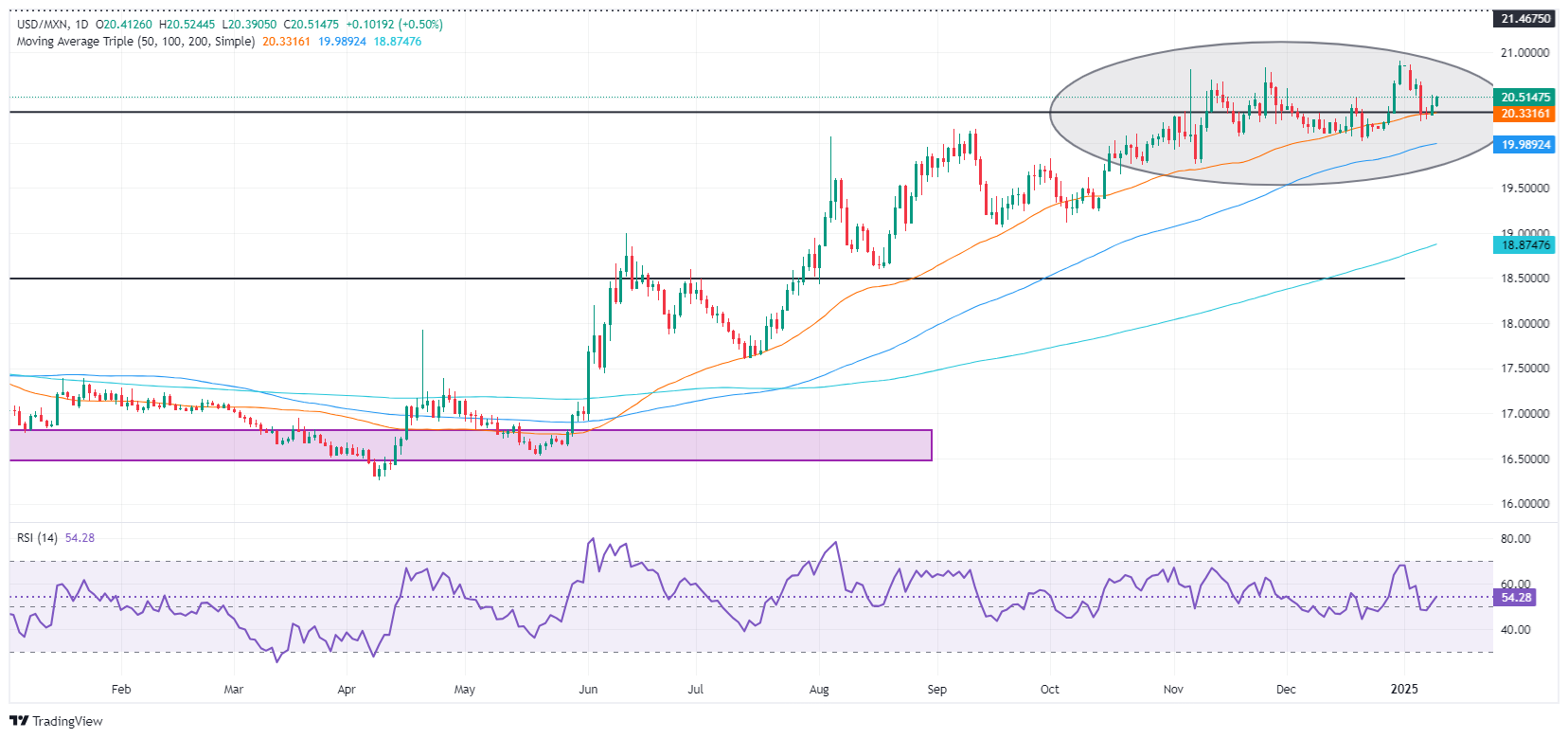Mexican Peso dives as Banxico signals aggressive easing
- Mexican Peso faces pressure after Banxico's dovish shift suggests larger, and possibly quicker, interest rate cuts.
- Mixed inflation data from INEGI maintains uncertainty, adding to Peso's volatility in light trading conditions.
- Interest rate differential concerns increase as Banxico's potential 150 bps cuts contrast with the Fed's more conservative 57 bps easing outlook.
The Mexican Peso loses some ground against the US Dollar on Thursday after the Banco de Mexico (Banxico) hinted that interest rates could be reduced faster in some meetings. This and the disinflation progress weighed on the Peso despite thin trading in observance of the funeral of former US President Jimmy Carter. The USD/MXN trades at 20.50, up 0.55%.
The Instituto Nacional de Estadística Geografía e Informatica (INEGI) revealed that inflation figures were mixed. However, Banxico turned dovish, while a member said it was necessary to increase the size of the rate cuts.
Therefore, the Peso would be at risk of further depreciation due to the reduction of the interest rate differential between Mexico and the US. Although Federal Reserve (Fed) officials stated they are in an easing cycle, but market players are eyeing just 57 basis points (bps) of easing in the US this year against 150 bps by Banxico.
Daily digest market movers: Mexican Peso weakened by dovish tone of Banxico minutes
- Banxico’s meeting minutes revealed the evolution of disinflation, suggesting that the easing cycle might continue to reduce the restiveness of monetary policy. To achieve that, the Governing board stated, “larger downward adjustments could be considered in some meetings.”
- Mexico’s central bank improved the inflation outlook due to the progress in headline and core inflation. Officials acknowledged that services inflation decreased, and they expect CPI to converge to its 3% goal in Q3 2026.
- INEGI revealed that December’s Consumer Price Index (CPI) dipped to 0.38% MoM below estimates of 0.40% and the prior month’s 0.44% jump. Core CPI in the same period increased by 0.51%, up from 0.05% in the prior reading and above the forecasted 0.45%.
- On an annual basis, headline inflation came in at 4.21%, missing projections of 4.28% and was beneath November’s 4.55% reading. Excluding volatile items, inflation modestly increased from 3.58% to 3.65%, exceeding expectations of 3.62%.
- On Wednesday, the Fed revealed its December Meeting Minutes. Officials opted to reduce borrowing costs by 25 basis points, but the minutes showed that "some participants saw merit in maintaining rates at current levels, citing the heightened risk of persistently high inflation."
- Despite this, policymakers expected inflation to continue moving toward the US central bank's 2% goal, although they acknowledged potential changes in trade and immigration policy. Several officials noted that the disinflationary process “stalled.” The Minutes underscored that Fed officials opened the door to slowing the pace of interest rate cuts.
USD/MXN technical outlook: Mexican Peso remains heavy as USD/MXN climbs above 20.35
The USD/MXN uptrend remains intact. During the week, sellers tried to push the exchange rate below the 50-day Simple Moving Average (SMA) of 20.29 but failed as the pair found acceptance near the 20.40 to 20.50 range.
If buyers clear the top of the range, the next resistance would be last year’s high of 20.83, followed by the current yearly high of 20.90. On further strength, the USD/MXN could test 21.00, ahead of the March 8, 2022 high at 21.46.
Conversely, if USD/MXN tumbles below the 50-day SMA, the next support would be the 20.00 figure, ahead of the 100-day SMA at 19.93, followed by the 19.50 figure.

Mexican Peso FAQs
The Mexican Peso (MXN) is the most traded currency among its Latin American peers. Its value is broadly determined by the performance of the Mexican economy, the country’s central bank’s policy, the amount of foreign investment in the country and even the levels of remittances sent by Mexicans who live abroad, particularly in the United States. Geopolitical trends can also move MXN: for example, the process of nearshoring – or the decision by some firms to relocate manufacturing capacity and supply chains closer to their home countries – is also seen as a catalyst for the Mexican currency as the country is considered a key manufacturing hub in the American continent. Another catalyst for MXN is Oil prices as Mexico is a key exporter of the commodity.
The main objective of Mexico’s central bank, also known as Banxico, is to maintain inflation at low and stable levels (at or close to its target of 3%, the midpoint in a tolerance band of between 2% and 4%). To this end, the bank sets an appropriate level of interest rates. When inflation is too high, Banxico will attempt to tame it by raising interest rates, making it more expensive for households and businesses to borrow money, thus cooling demand and the overall economy. Higher interest rates are generally positive for the Mexican Peso (MXN) as they lead to higher yields, making the country a more attractive place for investors. On the contrary, lower interest rates tend to weaken MXN.
Macroeconomic data releases are key to assess the state of the economy and can have an impact on the Mexican Peso (MXN) valuation. A strong Mexican economy, based on high economic growth, low unemployment and high confidence is good for MXN. Not only does it attract more foreign investment but it may encourage the Bank of Mexico (Banxico) to increase interest rates, particularly if this strength comes together with elevated inflation. However, if economic data is weak, MXN is likely to depreciate.
As an emerging-market currency, the Mexican Peso (MXN) tends to strive during risk-on periods, or when investors perceive that broader market risks are low and thus are eager to engage with investments that carry a higher risk. Conversely, MXN tends to weaken at times of market turbulence or economic uncertainty as investors tend to sell higher-risk assets and flee to the more-stable safe havens.

